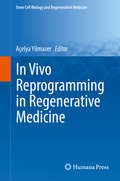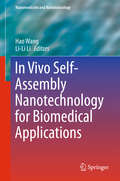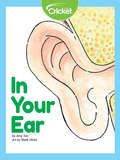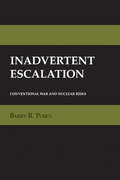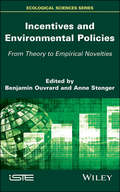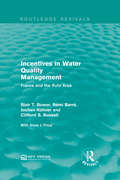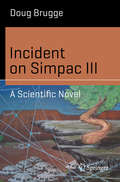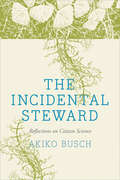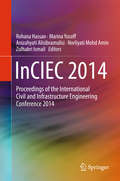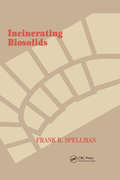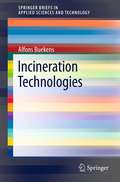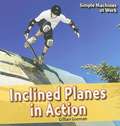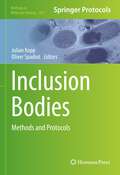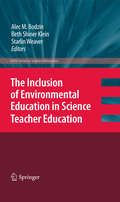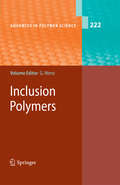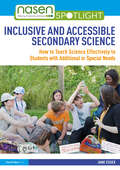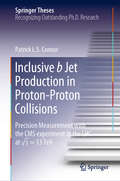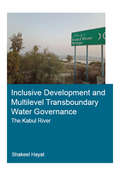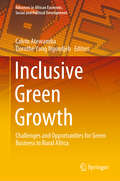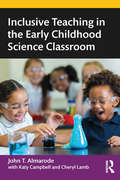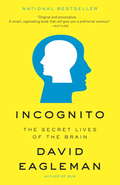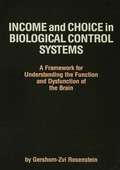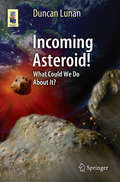- Table View
- List View
In Vivo Reprogramming in Regenerative Medicine
by Açelya YilmazerThis new volume reviews current progress on different approaches of in vivo reprogramming technology. Leaders in the field discuss how in vivo cell lineage reprogramming can be used for tissue repair and regeneration in different organs, including brain, spinal cord, pancreas, liver and heart. Recent studies on in vivo cell reprogramming towards pluripotency are reviewed; examples are given to show its potential in regenerative medicine. In each chapter, the regenerative potential of different in vivo reprogramming approaches is discussed in detail. More specifically, how different tissue failures or damages can be treated with this technology is explained. Examples from various animal models are given and the regenerative potential of in vivo reprogramming is compared to that of cell transplantation studies. The last chapter discusses current challenges of these preclinical studies and gives suggestions in order to improve the current strategies. Future directions are indicated for the transition of in vivo reprogramming technology to clinical settings. This is among the first books in the literature which specifically focuses on the in vivo reprogramming technology in regenerative medicine and these chapters collectively cover one of the most important and exciting topics of regenerative medicine.
In Vivo Self-Assembly Nanotechnology for Biomedical Applications
by Hao Wang Li-Li LiThis book reviews and discusses the development of self-assembled nanomaterials applied in biomedical fields. Based on self-assembled nanomaterial constructions, it highlights the mechanisms of the stimuli-response-induced assembly/disassembly and transformation. Moreover, it examines healthcare-related diseases, the applications of nanomaterials and therapy/detection strategies, providing readers with both a deeper understanding of the subject and inspirations for future research. The book is primarily intended for researchers and graduate students in the fields of material sciences and chemistry who wish to learn about the principles, methods, mechanisms and biomedical applications of self-assembled nanomaterials.
In War And Peace: My Life In Science And Technology
by Guy SteverScience came into Guy Stever’s life as a pure and peaceful pursuit. It was only later, as he walked through the wreckage of wartime London that he began to see science as central to a desperate struggle to survive.Past president of Carnegie Mellon University, former Chief Scientist of the U.S. Air Force, one-time Director of the National Science Foundation, professor at MIT for 20 years, member of the National Academies of Sciences and Engineering, and science advisor to two presidents…Guy Stever was a central figure in twentieth century science—consistently on the front lines, changing the fate of a nation.In this thoughtful and candid memoir, Stever recounts an extraordinary life that reveals as much about the man as about the major scientific and technological events of his day. Born of humble origins and orphaned at an early age, Stever journeyed from a small town in New York to work alongside British comrades who were developing and refining the critical radar technology that was to turn the tide of the war against the Germans. As a technical intelligence officer, these harrowing wartime years took him from the beachheads of Normandy to the German slave-labor factories responsible for building the V-2 rockets.Stever returned home committed to serving his country. He became intimately involved in America’s nascent guided missile program—and was to remain a key player in the anti-ballistic missile defense program that heralded the era of the Cold War. As the decades passed, Stever continued to exert lasting influence on countless scientific endeavors. He was instrumental in the formation of new institutions, from the creation of NASA in the post-Sputnik years to the merging of Carnegie Tech and the Mellon Institution, giving birth to Carnegie Mellon University. As Presidential Science Advisor to both Nixon and Ford, Stever shaped the very structure of contemporary presidential science advising. And he was to chair the oversight committee that redesigned the space shuttle boosters after the Challenger explosion.Guy Stever’s life offers remarkable insight into the twentieth century. Through his eyes, we relive the history of the past 50 years, witnesses to a tale of science and technology that is revealing in its scope and sweep.
In Your Ear
by Amy TaoDo you know how your ears can hear? Learn about the anatomy of your ear and how its structure allows you to hear all the different noises you experience every day!
Inadvertent Escalation
by Barry R. PosenIn this sobering book, Barry R. Posen demonstrates how the interplay between conventional military operations and nuclear forces could, in conflicts among states armed with both conventional and nuclear weaponry, inadvertently produce pressures for nuclear escalation. Knowledge of these hidden pressures, he believes, may help some future decision maker avoid catastrophe. Building a formidable argument that moves with cumulative force, he details the way in which escalation could occur not by mindless accident, or by deliberate preference for nuclear escalation, but rather as a natural accompaniment of land, naval, or air warfare at the conventional level. Posen bases his analysis on an empirical study of the east-west military competition in Europe during the 1980s, using a conceptual framework drawn from international relations theory, organization theory, and strategic theory. The lessons of his book, however, go well beyond the east-west competition. Since his observations are relevant to all military competitions between states armed with both conventional and nuclear weaponry, his book speaks to some of the problems that attend the proliferation of nuclear weapons in longstanding regional conflicts. Optimism that small and medium nuclear powers can easily achieve "stable" nuclear balances is, he believes, unwarranted.
Inanimation: Theories of Inorganic Life
by David WillsInanimation is the third book by author David Wills to analyze the technology of the human. In Prosthesis, Wills traced our human attachment to external objects back to a necessity within the body itself. In Dorsality, he explored how technology is understood to function behind or before the human. Inanimation proceeds by taking literally the idea of inanimate or inorganic forms of life. Starting from a seemingly naïve question about what it means to say texts "live on" or have a "life of their own," Inanimation develops a new theory of the inanimate.Inanimation offers a fresh account of what life is and the ethical and political consequences that follow from this conception. Inspired by Walter Benjamin's observation that "the idea of life and afterlife in works of art should be regarded with an entirely unmetaphorical objectivity," the book challenges the coherence and limitations of "what lives," arguing that there is no clear opposition between a live animate and dead inanimate. Wills identifies three major forms of inorganic life: autobiography, translation, and resonance. Informed by Jacques Derrida and Gilles Deleuze, he explores these forms through wide-ranging case studies. He brings his panoptic vision to bear on thinkers (Descartes, Freud, Derrida, Benjamin, Carl Schmitt, Jean-Luc Nancy, Roland Barthes), writers and poets (Hélène Cixous, Paul Celan, William Carlos Williams, Ernst Jünger, James Joyce, Georges Bataille), and visual artists (Jean-François Millet, Jean-Luc Godard, Paul Klee). With panache and gusto, Wills discovers life-forms well beyond textual remainders and translations, in such disparate "places" as the act of thinking, the death drive, poetic blank space, recorded bird songs, the technology of warfare, and the heart stopped by love.
Incentives and Environmental Policies: From Theory to Empirical Novelties
by Benjamin Ouvrard Anne StengerThe economic protection of the quality of the environment took shape properly in the middle of the 20th Century when various economic instruments were proposed to policymakers. Today, protecting the environment is essential, as evidenced in the rise in temperatures, the melting of the icecaps, the disappearance of animal species, etc. Moreover, with recent advances in other disciplines (notably in psychology), economists are turning more and more towards non-monetary forms of incentive. However, questions concerning the effectiveness of these forms arise.Incentives and Environmental Policies deals with the role of the economy in protecting the environment by revisiting traditional economic instruments and pursuing an advanced consideration of the role of new forms of incentive. It appears that, in order to strive towards the best possible environmental quality, policymakers will have to take into account the future of many combinations of socially acceptable incentives.
Incentives in Water Quality Management: France and the Ruhr Area (Routledge Revivals)
by Blair T. Bower Rémi Barré Jochen Kühner Clifford S. RussellIncentives in Water Quality Management explores the role of effluent charges in France and the Ruhr area of the federal republic of Germany by delving into both regulatory and economic systems that are utilised in the water quality management of these two areas. Originally published in 1981, these studies place an emphasis on the necessity of legislation in effective water quality management whilst attempting to create a complete picture of the water quality management systems in place in France and the Ruhr area. This title will be of interest to students of Environmental Studies.
Incident on Simpac III: A Scientific Novel (Science and Fiction)
by Doug BruggeA few hundred years into the future, a wave of space colonization follows a disastrous earlier attempt to inhabit nearby extrasolar planets. It is guided by a new computational method based on massive data-driven socio-cultural and socio-epidemiological modeling and using novel biological computers, fed with data on Earth’s history of successes and failures. Yet, in the newly settled Simpac system, some unexpected and worrying anomalies begin cropping up, making an urgent expedition to the system necessary: is it the underlying data, the computations, or is some unknown entity tampering with the space colonization program? A race against time ensues as the lives of four strangers begin to converge. While grounded in the social systems aspect, the author posits that the future is likely to be characterized by more biology-based tools than most contemporary science fiction – which most often relies entirely on non-biological hardware in terms of advanced technologies – predicts. The result is an entertaining and skillful blend of thriller and SF, complemented by a nontechnical appendix describing the underlying science.
The Incidental Steward: Reflections on Citizen Science
by Akiko BuschA search for a radio-tagged Indiana bat roosting in the woods behind her house in New York's Hudson Valley led Akiko Busch to assorted other encounters with the natural world--local ecological monitoring projects, community-organized cleanup efforts, and data-driven citizen science research. Whether it is pulling up water chestnuts in the Hudson River, measuring beds of submerged aquatic vegetation, or searching out vernal pools, all are efforts that illuminate the role of ordinary citizens as stewards of place. In this elegantly written book, Busch highlights factors that distinguish twenty-first-century citizen scientists from traditional amateur naturalists: a greater sense of urgency, helpful new technologies, and the expanded possibilities of crowdsourcing. The observations here look both to precisely recorded data sheets and to the impressionistic marginalia, scribbled asides, and side roads that often attend such unpredictable outings. While not a primer on the prescribed protocols of citizen science, the book combines vivid natural history, a deep sense of place, and reflection about our changing world. Musing on the expanding potential of citizen science, the author celebrates today's renewed volunteerism and the opportunities it offers for regaining a deep sense of connection to place.
InCIEC 2014
by Rohana Hassan Marina Yusoff Anizahyati Alisibramulisi Norliyati Mohd Amin Zulhabri IsmailThe special focus of this proceedings is to cover the areas of infrastructure engineering and sustainability management. The state-of-the art information in infrastructure and sustainable issues in engineering covers earthquake, bioremediation, synergistic management, timber engineering, flood management and intelligent transport systems. It provides precise information with regards to innovative research development in construction materials and structures in addition to a compilation of interdisciplinary finding combining nano-materials and engineering.
Incinerating Biosolids
by Frank R. SpellmanAbout the BookManaging biosolids for reuse and not for disposal is the focus of this book. The emphasis is placed on environmental compliance where the goal is the processing of treated biosolids to the production of a waste product (biosolids ash) that has been discarded in the past and to demonstrate that this particular waste byproduct has some value. When biosolids ash is managed for reuse and is not disposed of in the traditional manner, all sides win, including the environment.
Incineration Technologies
by Alfons BuekensWaste incineration is the art of completely combusting waste, while maintaining or reducing emission levels below current emission standards. Where possible, objectives include the recovering of energy as well as the combustion residues. Successful waste incineration makes it possible to achieve a deep reduction in waste volume, obtain a compact and sterile residue, and eliminate a wide array of pollutants. This book places waste incineration within the wider context of waste management, and demonstrates that, in contrast to landfills and composting, waste incineration can eliminate objectionable and hazardous properties such as flammability and toxicity, result in a significant reduction in volume, and destroy gaseous and liquid waste streams leaving little or no residues beyond those linked to flue gas neutralization and treatment. Moreover, waste incineration sterilizes and destroys putrescible matter, and produces usable heat. Incineration Technologies first appeared as a peer-reviewed contribution to the Encyclopedia of Sustainability Science and Technology. It provides detailed treatment of the challenges of this technically complex process, which requires huge investment and operating costs, as well as good technical skills in maintenance and plant operation. Particular attention is paid to technologies for ensuring the complete burn-out of flue gas and residues and for controlling the resulting pollutants.
Inclined Planes in Action (Simple Machines at Work)
by Gillian GosmanIn this fascinating book, readers will uncover why inclined planes make it easy to lift and move heavy objects. They will also learn where they can find inclined planes in their everyday life and conduct a simple experiment of their own.
Inclusion Bodies: Methods and Protocols (Methods in Molecular Biology #2617)
by Julian Kopp Oliver SpadiutThis detailed volume presents a series of protocols dealing with different aspects of inclusion body (IB) processing, from cloning procedures to purification of refolded product. Commencing with chapters on upstream processing, looking into different expression strategies for IB production, the book continues with downstream applications, highlighting early protein purification and subsequent analytics, as well as success stories of IB-based processes. Written for the highly successful Methods in Molecular Biology series, chapters include introductions to their respective topics, lists of the necessary materials and reagents, step-by-step and readily reproducible laboratory protocols, and tips on troubleshooting and avoiding known pitfalls. Authoritative and practical, Inclusion Bodies: Methods and Protocols serves as an ideal resource for facilitating diverse aspects of IB processing.
The Inclusion of Environmental Education in Science Teacher Education
by Starlin Weaver Beth Shiner Klein Alec BodzinIn the coming decades, the general public will be required ever more often to understand complex environmental issues, evaluate proposed environmental plans, and understand how individual decisions affect the environment at local to global scales. Thus it is of fundamental importance to ensure that higher quality education about these ecological issues raises the environmental literacy of the general public. In order to achieve this, teachers need to be trained as well as classroom practice enhanced. This volume focuses on the integration of environmental education into science teacher education. The book begins by providing readers with foundational knowledge of environmental education as it applies to the discipline of science education. It relates the historical and philosophical underpinnings of EE, as well as current trends in the subject that relate to science teacher education. Later chapters examine the pedagogical practices of environmental education in the context of science teacher education. Case studies of environmental education teaching and learning strategies in science teacher education, and instructional practices in K-12 science classrooms, are included. This book shares knowledge and ideas about environmental education pedagogy and serves as a reliable guide for both science teacher educators and K-12 science educators who wish to insert environmental education into science teacher education. Coverage includes everything from the methods employed in summer camps to the use of podcasting as a pedagogical aid. Studies have shown that schools that do manage to incorporate EE into their teaching programs demonstrate significant growth in student achievement as well as improved student behavior. This text argues that the multidisciplinary nature of environmental education itself requires problem-solving, critical thinking and literacy skills that benefit students' work right across the curriculum.
Inclusion Polymers
by Gerhard WenzThis book contains short and concise reports on physics and chemistry of polymers, each written by the world renowned experts. The book has the highest Impact Factor of all journals ranked by ISI within Polymer Science.
Inclusive and Accessible Secondary Science: How to Teach Science Effectively to Students with Additional or Special Needs (nasen spotlight)
by Jane EssexDrawing on extensive professional experience and detailed empirical evidence, this resource sets out an insightful, highly practical approach to teaching science to secondary-aged students with learning difficulties and other special educational or additional support needs (SEND/ASN). The book explores the barriers that the secondary school science curriculum currently presents to those who do not learn in the expected way, before providing a wealth of practical strategies to help teachers, in both specialist and mainstream settings, to make science more accessible. Multiple science topics are covered in depth, including living and non-living matter, the periodic table, electrical energy, the solar system, the environment and more. Each topic is supported by extensive teachers’ notes outlining activities that will allow educational practitioners to enact the principles of accessibility in the classroom. With rich field notes and practical takeaways included to accompany key insights, this accessible book will provide science teachers at the secondary school level, as well as support staff and anyone aspiring to teach science to SEN/ASN learners, with the guidance and resources they need to make science education meaningfully inclusive.
Inclusive b Jet Production in Proton-Proton Collisions: Precision Measurement with the CMS experiment at the LHC at √ s = 13 TeV (Springer Theses)
by Patrick L.S. Connor^ 74 GeV and |y|
Inclusive Development and Multilevel Transboundary Water Governance - The Kabul River (IHE Delft PhD Thesis Series)
by Shakeel HayatThe four decades long ideological-based insurgencies and conflict in the Kabul River Basin (KRB) have seriously hampered the relations and foreign policies of both Afghanistan and Pakistan. Consequently, it restricts them to solve various bilateral issues including transboundary waters. This lack of cooperation over shared water resources is one of the barriers to achieve inclusive and sustainable development. Additionally, it has contributed to the prevailing anarchic situation where each country does what it wants. The absence of a formal water-sharing mechanism coupled with poor water management practices within both the riparian counties are resulting various flow and administration-related challenges. Moreover, these challenges are further exacerbated by regional changes in social, political, environmental and economic systems. The scholarly literature suggests that an analytical transboundary water governance framework is essential to address the challenges of water politicisation and securitisation, quality degradation and quantity reduction. Additionally, the literature rarely integrates (a) a multi-level approach, (b) an institutional approach (c) an inclusive development approach, or (d) accounts for the uses of different types of water and their varied ecosystem services for improved transboundary water governance. To enhance human wellbeing and achieve inclusive and sustainable development in the KRB this research indicates that it is essential to: (1) defrost frozen collaboration; (2) bypass border dispute; (3) use biodiversity and ecosystem services approach; (4) address existing and potential natural and anthropogenic challenges; (5) remove contradictions in the policy environment; (6) combat resource limits and dependence by promoting collaboration on long-term cost effective solutions; and (7) enhance knowledge and dialogue on inclusive development.
Inclusive Green Growth: Challenges and Opportunities for Green Business in Rural Africa (Advances in African Economic, Social and Political Development)
by Calvin Atewamba Dorothé Yong NgondjebFostering inclusive green growth in Africa means addressing existing and emerging development challenges, while efficiently managing Africa’s natural capital and building resilience to environmental, social and economic risks. Although this new paradigm for development has the potential to create tremendous business opportunities, there are also challenges. This book provides empirical evidence on the conditions for the emergence of green businesses in Africa. It includes 13 case studies, which identify the determinants of small and medium-size enterprises’ engagement in inclusive and sustainable growth in rural Africa, and the factors that hinder eco-innovation in business and entrepreneurial activities. Furthermore it discusses appropriate regulations and policies to stimulate the development of green business in Africa. Offering insights into the relationship between eco-innovation, labor productivity and business competitiveness in rural Africa, this book appeals to scholars, policy makers and practitioners interested in a green economy for Africa.
Inclusive Teaching in the Early Childhood Science Classroom
by John T. AlmarodeFocused on engaging all students, Inclusive Teaching in the Early Childhood Science Classroom walks readers through the process of planning, developing, and implementing science instruction for early learners. Drawing on a range of pedagogical processes and approaches, this comprehensive text links science to other disciplines and explores how we develop language, social-emotional, and content learning through early childhood science. Each chapter is framed around an essential question and features success criteria and reflection tasks to guide readers through the content. Aligned with the Next Generation Science Standards and addressing the Interstate New Teacher Assessment and Support Consortium Model Core Teaching Standards, this textbook is critical reading for preservice teacher education students enrolled in an inclusive early childhood or early childhood science methods course.
Incognito: The Secret Lives of the Brain
by David EaglemanIf the conscious mind--the part you consider to be you--is just the tip of the iceberg, what is the rest doing? In this sparkling and provocative new book, the renowned neuroscientist David Eagleman navigates the depths of the subconscious brain to illuminate surprising mysteries: Why can your foot move halfway to the brake pedal before you become consciously aware of danger ahead? Why do you hear your name being mentioned in a conversation that you didn't think you were listening to? What do Ulysses and the credit crunch have in common? Why did Thomas Edison electrocute an elephant in 1916? Why are people whose names begin with J more likely to marry other people whose names begin with J? Why is it so difficult to keep a secret? And how is it possible to get angry at yourself--who, exactly, is mad at whom? Taking in brain damage, plane spotting, dating, drugs, beauty, infidelity, synesthesia, criminal law, artificial intelligence, and visual illusions, Incognito is a thrilling subsurface exploration of the mind and all its contradictions.
Income and Choice in Biological Control Systems: A Framework for Understanding the Function and Dysfunction of the Brain
by Gershom-Zvi RosensteinThis volume introduces the concepts of income and optimal choice to the realms of brain activity and behavior regulation. It begins by developing the concept of the Income-Choice approach in the field of biological control systems, then deals with the problems of control of brain activity, and finally presents a model of behavior disturbance based on the idea that its cause is a definite and simple change in the income system of the organism. Other areas to which the proposed Income-Choice approach could be applied are also addressed including the origin of the epileptic aura and why it is a predictor of the imminent attack, the mechanism of the phenomena of "personality switching" in schizophrenics, and the possible connection between schizophrenic- like symptoms and epileptic status. Written nearly 20 years ago in Russia and now published in the West, this book will be of value to many professionals in related fields. This volume introduces the concepts of income and optimal choice to the realm of brain activity and behavior regulation. It begins by developing the concept of the Income-Choice approach in the field of biological control systems, then deals with the problems of control of brain activity, and finally presents a model of behavior disturbance based on the idea that its cause is a definite and simple change in the income system of the organism. Other areas to which the proposed Income-Choice approach could be applied are also addressed, including the origin of the epileptic aura and why it is a predictor of the would-be attack, the mechanism of the phenomena of "personality switching" in schizophrenics, and the possible connection between schizophrenic- like symptoms and epileptic status. Originally written nearly 20 years ago in Russia and now published for the first time in the West, this book will be of value to many professionals in related fields.
Incoming Asteroid!
by Duncan Lunan'Incoming Asteroid!' is based on a project within ASTRA (the Association in Scotland to Research into Astronautics) to provide scientific answers to the question - what would we do if we knew there was going to be an asteroid impact in ten years' time or less? Clearly there are many things humanity can do nothing about, for example an unseen object traveling towards us so fast that we have no time to prepare, or an object so large it may be unstoppable. A realistic hazard model was decided upon, and the scenario developed from that: an incoming object about 1 kilometer in diameter, in an orbit ranging from the outer rim of the Asteroid Belt to within that of Earth's. Three basic possibilities are considered in this book. The first is the deflection of the asteroid, using remote probes along with a number of possible technologies to change the asteroid's course. Second is the attempt of a manned mission, in order to plant a propulsion system on the asteroid to push it into a different orbit. Third is the nuclear option, a last-ditch attempt to break up and then disperse the asteroid using nuclear weapons. (A rather impractical combination of these second and third options were used as the plot of the popular 1998 Bruce Willis feature film, Armageddon. ) Although the cost of developing the technology needed to protect the Earth would be substantial, there would certainly be spin-off benefits. These could eventually result in practical small-scale atomic energy sources, new propulsion systems that could make extraterrestrial mining within the solar system a possibility, and other as-yet unforeseen benefits. And finally, Incoming Asteroid! considers the political implications - how governments across the world should best react to the threat with a view to minimizing loss of life, and in the weeks running up to the possible impact, preventing panic in the population.
